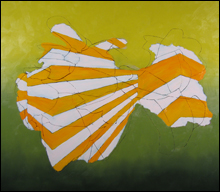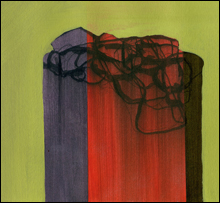An artist gets his due in four shows By: CHRISTOPHER MILLIS7/24/2006 6:31:48 PM

NARKEETA: If paintings are a puzzle, these are the assembled solutions.
|
I once asked a gallery director how he decides whether to consider representing an artist, and he confessed to having what he called “the rule of three”: if three different parties independently recommended he check somebody out, that’s when he scheduled a studio visit. One Boston artist has gone that rule one better, simultaneously occupying the Project Space of the Bromfield Gallery and being the subject of a solo show of paintings at the Artists Foundation Gallery as well as the featured artist in the Bernard Toale Gallery’s ongoing Boston Drawing Project and a contributor to the summer group show at Tufts University with two of his signature wall manipulations. Chris Nau (rhymes with “cow”) is riding a surge. His popularity is deserved.
This recent work gives a sense of his studied playfulness. He brings an anthropologist’s sensibility — exploratory field work to be sure, but deliberate to the point of mathematical — to his colorful abstract forms. At the center of his paintings and woodblock prints looms a multi-sided, typically striped shape, and within those simple constants of outer edge and inner content begins one of many tensions at work in his frames. The stripes themselves are angular and bold; the shapes they zigzag across have had all their edges pressed into soft contours. Imagine a package with adhesive wrapping that’s been worked over by a rock tumbler or the tide or UPS. Metaphors quickly break down in trying to describe Nau’s imagery, however, since there’s no making sense of how the sharp definition of the patterns coexists with the randomly amorphous forms to which they belong — except that those same words can also be applied to the detritus of train wrecks and car accidents and the aftermath of natural disasters. Integrity and dissolution balance each other. And yet nothing explicitly suggests damage: no edges blacken, nothing appears cut off or incomplete or compromised. After considerable pondering of these images, the nearest I could get to a simile was thinking that this is what space debris must be like: improbable manufactured heaps whose purpose has passed and whose former velocity and direction have been reduced to gravity-free floating.
Floating is indeed another recurrent Nau motif, particularly in the paintings where the background washes of color are not the blue-black of outer space you might expect but instead the subtle tones, sometimes uniform, sometimes graduated, that complement the bright hues of the central figures. Nothing especially new or groundbreaking there, except for the nature of the colors themselves, which enjoy a weird, industrial quality — the sort of hues you might expect on the bathroom walls of a house built in 1958. Again, the effect is disarming. What’s to be made of brick-red stripes interspersed with swaths of police-barricade yellow?

Aquitania
|
That Nau is a master at evading literal meanings does not make his art a purely intellectual exercise, even as you get the impression that the paintings signify complex problem sets, a point made further evident by yet another level of complexity. (His titles, when he uses them, don’t help.) The paintings, all on wood, appear flat but only from a distance; in fact they have been incised and fitted back together. The tracks that appear to run every which way across their interiors are the slight shadows cast by the separated sections. If paintings are a puzzle, these are the assembled solutions. A technique like this could appear gimmicky, but since the pull between wholeness and coming apart expresses itself elsewhere, the sawed-into surfaces feel like a natural extension of Nau’s concerns. The incisions do not conform in any predictable way to the contours of the central image in each picture, though that’s where they concentrate. Still, some veer off into the background while most define a tightly packed archipelago of irregularly sized islands of wood. Nau paints objects that cannot be identified on surfaces that cannot be called exactly flat, in colors that cannot readily be classified. The result — dispassionate, cerebral, and balanced — is curiously non-visual. You come away from his acrylics with an impression less of what you’ve seen than of what you’ve been made to think. He’s a philosopher wielding a paintbrush.
ADVERTISEMENT
 |

Untitled 1276
|
With a woodblock, he’s something else — a singer, perhaps a balladeer. In his paintings, Nau the strategist plots formations and movements, anticipates responses, measures counter moves. In his prints, he trades in his uniform for weekend wear — relaxed, lyrical, pleasure-seeking. The shapes at the center are the same hybrids of design and unpredictability, and the surrounding space is on the same scale. What’s different is the integration of foreground to background, the less confrontational colors, the general ease. For one thing, the colors of the prints are, if not lush, then soothing. Orange stripes against a sky-blue background suggest a rising sun in DZOB. A pattern of deep green stripes is set off by complementary cream-colored counterparts in DZGC, like a configuration you might see looking up to the sky from the base of a redwood forest. Radio Break, executed in a block-like patchwork of fuchsia and black, recalls hand-colored ward maps of a century ago; the curving lines that worm over the image (in a Nau painting, those lines would be incisions) read like the trail of a commuter rail. In his only black-and-white work (besides the wall cuts at Tufts), Crooked Particle, the central shape (it vaguely resembles a crumpled sheet of paper) stands poised between two curtains of miniature waves that cascade down either side; where the shape overlaps the curtains, the waves penetrate it and become vertical. Gravity, direction, permeability, and form are all up for grabs.
|
 |
|
|
- SEX (CIRCA 2006) Oral is the new second base, the “mostly” girls keep on kissing girls, and the Bro Job has arrived (but is still not ready for its close-up)
- WHAT NOW? Republican defeats are just the first step in turning the nation around. Plus, the constitutional imperative of gay marriage.
- THE NAKED SORORITY Never mind its tough-girl alt-porn feminism: SuicideGirls has already moved on to a new generation
- WHATEVER HAPPENED TO MEMOGATE? Waiting for the Globe’s mea culpa
- COP OR DRUG DEALER? Roberto Pulido’s story shows how easily the divide between law-keepers and law-breakers can break down — if nobody is paying attention
- HARMONIC INSURGENTS The graphic intensity of Converge
|

|